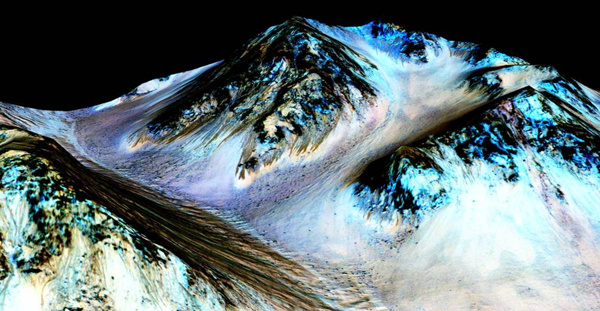NASA finds 'strong' evidence for liquid water on Mars
 0 Comment(s)
0 Comment(s) Print
Print E-mail Xinhua, September 29, 2015
E-mail Xinhua, September 29, 2015
 |
|
U.S. space agency NASA announced on Monday it has found "strong" evidence that there is liquid water intermittently flowing on present-day Mars. [Photo/NASA] |
U.S. space agency NASA announced on Monday it has found "strong" evidence that there is liquid water intermittently flowing on present-day Mars.
Images taken from the Mars orbit showed dark, finger-like markings that, typically less than five meters in width, appear on slopes during warm seasons, lengthen and then fade during cooler seasons on the Red Planet.
These surface features, known as recurring slope lineae (RSL), have been hypothesized to form by the activity of brines, but direct evidence has been lacking.
Now, using an imaging spectrometer from NASA's Mars Reconnaissance Orbiter (MRO), researchers detected signatures of hydrated minerals on slopes where the mysterious streaks are seen on Mars.
"Our quest on Mars has been to 'follow the water,' in our search for life in the universe, and now we have convincing science that validates what we've long suspected," said John Grunsfeld, associate administrator of NASA's Science Mission Directorate in Washington.
"This is a significant development, as it appears to confirm that water -- albeit briny -- is flowing today on the surface of Mars."
These puzzling surface features were first noticed in 2010 by Lujendra Ojha, then a University of Arizona undergraduate student, using images from the MRO's High Resolution Imaging Science Experiment.
In the new study, Ojha, now a graduate student at Georgia Institute of Technology, and his colleagues analyzed spectra data from the Compact Reconnaissance Imaging Spectrometer for Mars (CRISM) aboard the MRO from four different locations where the RSL features were present.
They reported in the British journal Nature Geoscience that signatures of hydrated salts at these RSL locations existed only when the dark features were relatively wide.
"We found the hydrated salts only when the seasonal features were widest, which suggests that either the dark streaks themselves or a process that forms them is the source of the hydration," Ojha said.
"In either case, the detection of hydrated salts on these slopes means that water plays a vital role in the formation of these streaks."
The researchers interpreted the spectral signatures as caused by hydrated minerals called perchlorates, which are likely a mixture of magnesium perchlorate, magnesium chlorate and sodium perchlorate.






Go to Forum >>0 Comment(s)